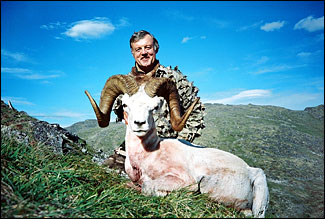back to MUSEUM

This spectacular thirteen (13) year old Dall Sheep ram epitomizes the success of trapper and hunter caretakers in the Northwest Territories of Canada. The age of wild sheep can be determined (generally before stalking) by counting the annual rings in its horns (not antlers that are shed and regrown each year). Like a great oak, the wild sheep’s horns grow most during the spring and summer and then recede during winter (making a visible indentation). Generally a wild ram of ten (10) years is the maximum of its age, with eleven (11) year old rams exceedingly rare.
This means that if hunters harvest ten (10) year or older wild rams that have sired new generations during the past, they are merely saving them from the trauma of an agonizing death the following winter by starvation or wolves. A feature of wolves’ hunting activity that is rarely, if ever, mentioned in film documentaries, but frequently related by caretakers of the wild north and a neighbor who spent myriad time in Yellowstone with wolves in winter, reflects the severity of winter in the mountains.
With temperatures reaching more than 40 degrees below zero overnight, what would happen to the carcass of a wild ram killed during a day and not completely devoured by nightfall? Obviously it would be frozen solid and therefore no longer a food source for the wolf pack. How do wolves solve the problem of maintaining their food source overnight when they have gorged to the maximum the day of the kill? Obviously they need to make sure that the carcass remains unfrozen overnight by having warm blood flow through the near kill. This means that they do not kill the wild sheep, moose, caribou, or deer when they first take it down after a harried chase. Rather they debilitate their food source without killing it, eat it's hind quarters and other areas that will not lead to its quick painless death while it writhes in pain, leave it for the birds to feast on their favorite food (eyeballs), and then return in the morning to the still living or just dead quarry. The quick painless penetration of an arrow through the vitals (have you ever cut yourself while shaving and felt no pain until after you see our own blood?) causing euthanasia is far more humane than Nature’s required serving table.
According to the film documentary “Alone in the Wilderness”, a wolf kills on average twenty-three (23) caribou per year. The video commentator also recounted his dismay and sadness of finding a caribou calf in the early spring that had its hamstrings ripped by wolves and was just left to die slowly and was not eaten by the wolves. Many who anthropomorphize wild animals’ actions, may want to consider this action.
The wild north caretakers plight was recounted in the Tuesday, February 4, 2003 New York Times on Page A6 in “The War Against the Fur Trade Backfires, Endangering a Way of Life.” It quotes Elizabeth May, executive director of the Sierra Club Canada:
“The collapse of the fur trade was a disaster for people who are guardians of the environment.”
She now proposes:
“that fur trapped by Canadian Natives be labeled as such to promote their acceptance among environmentally minded consumers.” The article continues the reasoning: “Trappers who once used to report to environmental groups when logging companies were clear-cutting forest or to the Canadian military when low-flying jets were disrupting caribou herds are no longer in a position to perform those custodial roles.”
The law of unintended consequences has disrupted the custodial/guardian roles of all trappers and hunters whether “Native” or merely native to the Americas. (Does native denote someone born here or someone who has always been here? “Native Americans” have not always been here, their ancestors migrated here just like the ancestors of the founders of MāHUNT. With the discovery of a 30,000 year old hunting village in Northern Siberia not an immense distance from the Bering Sea, northern Europeans may have been the first “Native Americans” since the earliest previous discovery in Monte Verde in Chile was only 15,000 years ago.) Without the incentive to protect and preserve wilderness and wildlife, hunters and trappers will not pay the price of hardship and money to ensure that places of solitude and wildness exist for all to experience directly in the future.